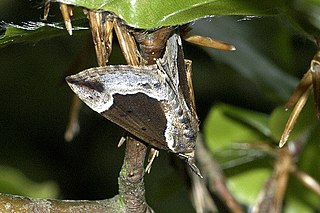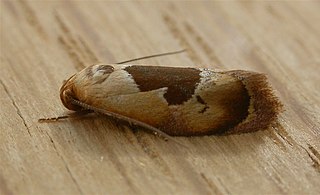
Hypena rostralis, the buttoned snout, is a moth of the family Erebidae. It is found in Europe far into Scandinavia.Then through the Palearctic into Asia Minor, the Caucasus and east to Siberia. It is widespread at forest edges, forest clearings, shore areas, in gardens, park landscapes and cultivated land and rises in the mountains up to 1600 m.

Hypena crassalis, the beautiful snout, is a moth of the family Erebidae. The species was first described by Johan Christian Fabricius in 1787. It is found in Europe.

Hoplomorpha camelaea is a moth in the family Oecophoridae first described by Edward Meyrick in 1888. It is found in Australia, where it has been recorded from Victoria, Queensland, New South Wales and the Australian Capital Territory.

Mesapamea secalis, the common rustic, is a moth of the family Noctuidae. The species was first described by Carl Linnaeus in his 1758 10th edition of Systema Naturae. It is found in Europe, north-west Africa, Turkey and northern Iran.

Trigonodes hyppasia, the triangles or semi-looper, is a moth in the family Erebidae. The species was first described by Pieter Cramer in 1779. It is largely cosmopolitan, found throughout Borneo, Fiji, India, Nepal, Sri Lanka, São Tomé and Príncipe, Taiwan, Thailand, Zimbabwe, northern Australia, and almost all African countries.

Grotella dis is a moth in the genus Grotella, of the family Noctuidae. The species was first described by Augustus Radcliffe Grote in 1883. This moth species is found in North America, from the Argus mts. in Kansas to North Mexico.

Acylita distincta is a species of moth of the family Noctuidae first described by E. Dukinfield Jones in 1908. It is found in Brazil. Its wingspan is about 26 mm.
Chersotis fimbriola is a moth of the family Noctuidae. It is found in number of isolated populations from Austria to Spain, Morocco, Turkey, Iraq, Iran and Turkmenistan.
Nymphicula tariensis is a moth in the family Crambidae. It was described by David John Lawrence Agassiz in 2014. It is found in Papua New Guinea.
Sufetula polystrialis is a moth in the family Crambidae. It was described by George Hampson in 1912. It is found on the Louisiade Islands.
Syllepte leucographalis is a moth in the family Crambidae. It was described by George Hampson in 1912. It is found in Indonesia (Bali).
Ebbepterote is a monotypic moth genus in the family Eupterotidae. It was erected by Rolf G. Oberprieler, Wolfgang A. Nässig and Edward David Edwards in 2003. Its only species, Ebbepterote expansa, was described by Thomas Pennington Lucas in 1891. It is found in Australia, where it has been recorded from Queensland.
Compsolechia caryoterma is a moth of the family Gelechiidae. It was described by Edward Meyrick in 1922. It is found in Amazonas, Brazil.
Iulota triglossa is a moth of the family Gelechiidae. It was described by Edward Meyrick in 1904. It is found in Australia, where it has been recorded from Tasmania.
Chlamydastis bifida is a moth of the family Depressariidae. It is found in Brazil and the Guianas.
Cryptophasa mesotoma is a moth in the family Xyloryctidae. It was described by Edward Meyrick in 1925. It is found on Buru in the Maluku Islands.
Psittacastis trierica is a moth in the family Depressariidae. It was described by Edward Meyrick in 1909. It is found in Bolivia.
Hypercallia chionastra is a moth in the family Depressariidae. It was described by Edward Meyrick in 1926. It is found in Colombia.
Hypercallia alexandra is a moth in the family Depressariidae. It was described by Edward Meyrick in 1909. It is found in Peru.
Antaeotricha refractrix is a moth in the family Depressariidae. It was described by Edward Meyrick in 1930. It is found in Brazil.




